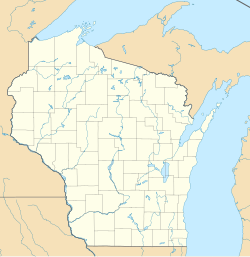
Richard Upjohn was a British architect who emigrated to the United States and became most famous for his Gothic Revival churches. He was partially responsible for launching the movement to popularity in the United States. Upjohn also did extensive work in and helped to popularize the Italianate style. He was a founder and the first president of the American Institute of Architects. His son, Richard Michell Upjohn, (1828-1903), was also a well-known architect and served as a partner in his continued architectural firm in New York.
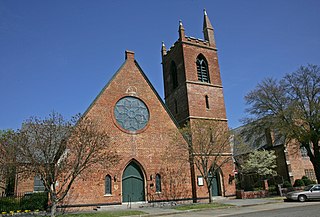
St. Paul's Episcopal Church is an historic red brick Gothic Revival church located at 210 Lauderdale Street in Selma, Dallas County, Alabama, United States. The parish was established in 1838 and its original sanctuary building was burned on April 2, 1865 during the Battle of Selma, with credit for that act going to Union General James H. Wilson. The current building was designed by the famous New York City architectural firm of Richard Upjohn and was completed in 1875.

St. John the Baptist Church is a historic Episcopal church located at 118 High Street in the Sanbornville village of Wakefield, New Hampshire, in the United States. Built 1876–77, it is a prominent regional example of Carpenter Gothic architecture. It was listed on the National Register of Historic Places in 1984. Information about the church and leadership can be found on their website.
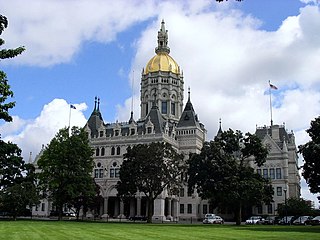
Richard Michell Upjohn, FAIA, was an American architect, co-founder and president of the American Institute of Architects.

Christ Episcopal Church, also known as Christ Church on Capitol Square, is an Episcopal church at 120 East Edenton Street in Raleigh, North Carolina. Built in 1848–53 to a design by Richard Upjohn, it is one of the first Gothic Revival churches in the American South. The church was built for a parish established in 1821; its minister is the Rev. James P. Adams. It was declared a National Historic Landmark in 1987.

Trinity Episcopal Church is a historic Episcopal church located in Oshkosh, Wisconsin. The only Episcopal church in Oshkosh, Trinity is in the Diocese of Fond du Lac. The congregation first met in 1850, organizing as Trinity Episcopal Church in 1854. The current church building, which was constructed in 1887, is an example of Richardsonian Romanesque architecture. It was added to the National Register of Historic Places in 1974.

Grace Church is an historic Episcopal church at 300 Westminster Street at Mathewson Street in downtown Providence, Rhode Island. It was built in 1845–1846 and was designed by Richard Upjohn in the Gothic Revival style.
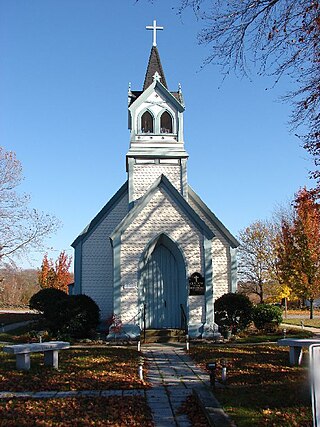
The Church of the Holy Cross in Middletown, Rhode Island, is a parish church of the Episcopal Diocese of Rhode Island of The Episcopal Church. The church is located at 1439 West Main Road, Middletown, Rhode Island. It is an early example of Richard Upjohn's work in translating Gothic architecture from stone to affordable designs for small, wooden churches. Built in 1845, Holy Cross Church exemplifies the architecture made accessible by the publication in 1852 of Upjohn's book, Rural Architecture. In its survey of Middletown's architectural resources, the Rhode Island Historical Preservation Commission recommended the Church of the Holy Cross for inclusion in the National Register, along with Upjohn's more luxurious Italianate Hamilton Hoppin House.

St. John's-In-The-Prairie, now known as St. John's Episcopal Church, is a historic Episcopal church in Forkland, Alabama.
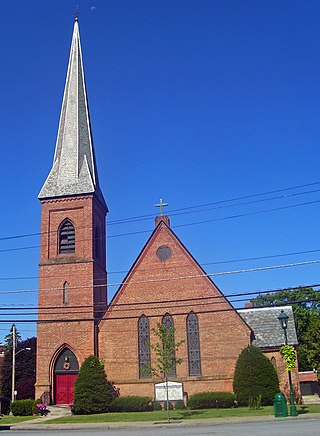
St. Andrew's Episcopal Church is located at the corner of Walnut and Orchard Street in the village of Walden, New York, United States. It is a brick Gothic Revival structure designed and built in 1871 by Charles Babcock, a former partner of Richard Upjohn. Located at the center of town, near the village hall, it is a local landmark that dominates the village's skyline.

St. Peter's Episcopal Church of Peekskill, New York, United States, is located on the north edge of the city's downtown. It is a three-building complex of stone Late Gothic Revival buildings on a half-acre dating to the late 19th century and added onto at successive later dates.
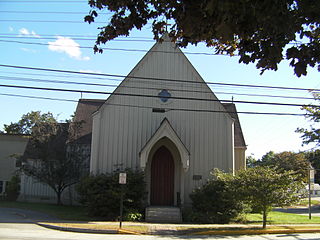
St. Paul's Episcopal Church is a historic church at 27 Pleasant Street in Brunswick, Maine. Built in 1845, it is a distinctive early example of a modest Carpenter Gothic design by Richard Upjohn, then already well known for his larger-scale Gothic churches. The building was listed on the National Register of Historic Places in 1978. The rector is Rev. Carolyn H. Eklund.

St. Luke's Episcopal Church is a historic Episcopal church located on Bedford Road in Katonah, New York, United States. It is a Tudor Revival structure dating to the early 1920s, housing a congregation restarted in the early 20th century.

St. Thomas' Episcopal Church is located on Leedsville Road in Amenia Union, New York, United States. It is a mid-19th century brick church designed by Richard Upjohn in the Gothic Revival architectural style, built for a congregation organized shortly before.

St. James' Episcopal Church is a congregation of the Episcopal Church in La Grange, Texas, under the Episcopal Diocese of Texas. Its campus at Monroe and Colorado Streets includes its historic parish church as well as a sacristy, preschool, and parish hall.

St. Paul's Episcopal Cathedral, is located in downtown Des Moines, Iowa, United States. It is the cathedral church of the Episcopal Diocese of Iowa. The building was listed on the National Register of Historic Places as St. Paul's Episcopal Church.

St. Stephen's Church, also known as St. Stephen's Episcopal Church, is an historic church located at 6807 Northumberland Highway, Heathsville, Northumberland County, in the Northern Neck of Virginia. Built in 1881, it was designed in the Carpenter Gothic style by T. Buckler Ghequiere. On December 28, 1979, it was added to the National Register of Historic Places. It remains in use by an active parish in the Episcopal Diocese of Virginia. It is located in the Heathsville Historic District.

Trinity Episcopal Church is a parish church in the Episcopal Diocese of Iowa. The church is located in Iowa City, Iowa, United States. It was individually listed on the National Register of Historic Places in 1974. In 2021, the building was included as a contributing property in the Iowa City Downtown Historic District.
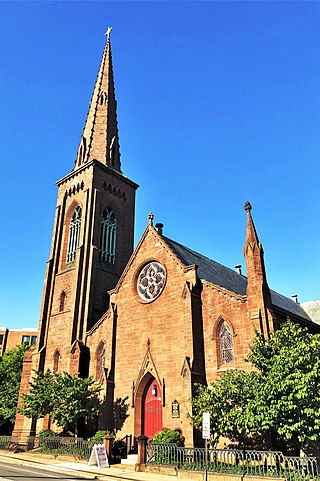
St. James Episcopal Church at 76 Federal Street at the corner of Huntington Street in New London, Connecticut is a historic church in the Episcopal Diocese of Connecticut. The congregation was founded in 1725, and the current church – the congregation's third – was built from 1847 to 1850 to designs in the Gothic Revival style by Richard Upjohn.
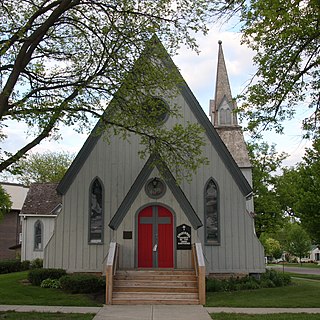
Church of the Good Shepherd Episcopal, a notable example of Rural Gothic architecture located at Moore and 8th Streets in Blue Earth, Minnesota, is the oldest surviving church building in the community. As the congregation diminished in the 1970s regular worship services were eventually suspended; in 1981 its three remaining members donated the building to the Faribault County Historical Society. Since then the church has hosted seasonal ecumenical services, Christmas concerts, weddings, and funerals. It was added to the National Register in 1980.

